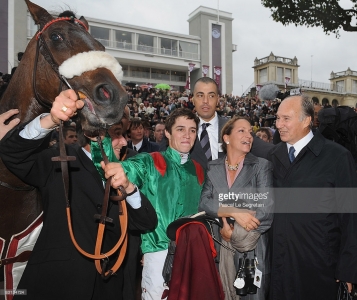Zarkava is latest star from Aga Khan's endless line - 2008-09-28
On Sunday, Zarkava will put her unbeaten record on the line in attempting to become the Aga Khan's fourth winner of the Prix de l'Arc de Triomphe at Longchamp, recognised as the pinnacle of achievement for middle-distance horses in Europe.
The Aga has raced some pretty special fillies in his time, including Aliysa, whose disqualification from the 1989 Oaks led to the owner boycotting British racing for some four years, but Zarkava looks like the best of them all.
Her stunning display in the Prix Vermeille over the Arc course and distance two weeks ago was her sixth in succession, following her three-lengths win in the Prix de Diane (French Oaks) in June. Said not to have pleased her trainer, Alain de Royer-Dupré, in her last piece of work before the Vermeille, Zarkava showed that she is a little bit of a madam - or madame - by coming out of the stalls several lengths behind the others, briefly looking as though she would refuse to race. Those antics meant she had to come from last to first in the home straight, something that should not have been easy, even after a strong gallop. The way she swept down the outside was a joy to behold and it appears that her temperament is the main obstacle standing between her and victory next week.
As wide as his racing web stretches, it is not for horses that the Aga Khan is best known, for he is revered by around 20 million Ismaili Muslims spread over about 25 countries. Considered a direct descendant of the prophet Muhammed and their 49th Imam, or spiritual leader, his interpretations on matters of religion are adhered to by the Ismailis.
Many Ismailis pay a proportion of their income to the Aga, funding institutes such as the Aga Khan Development Network, which backs cultural, educational and humanitarian projects worldwide - a $1 billion grant for improved housing in northern Pakistan being one of this year's initiatives.
Not long after the Aga inherited his title from his grandfather - his playboy father Aly Khan was passed over for the succession as Imam - at the age of 20 in 1957, he was forced to take up his father and grandfather's racing and breeding interests as a result of his father's death in a car crash.
His grandfather had won no fewer than 17 British Classics, including the Derby five times and the Triple Crown with Bahram in 1935, yet the young Aga admitted that: 'I wasn't in the least interested in horse racing, but my father's establishment was more than just a sport, it was a huge institution.'
There were more than 100 staff and nearly 300 horses to consider. 'I waited for six months and turned it over in my mind and in the end decided I could reorganise my life to include horse racing,' he said.
Not only did he enjoy the racing and the breeding, he was good at it, producing the winners of countless big races. He jointly holds the record for the most Derby wins - four - by an owner-breeder and the names of his top horses roll off the tongues of followers of the sport, including Sinndar, Dalakhani, Daylami, Shahrastani, Blushing Groom and, most emotive of all, Shergar, the runaway 1981 Derby winner, whose stud career - and life - was cut short when he was kidnapped in 1983.
When Aliysa lost her Oaks win after failing a drugs test, many people took the owner's decision to pull out of British racing as a toys-out-of-the-pram moment. That does not appear to have been the case. The source of the camphor in Aliysa's system, found in such small quantities that it could have had no influence on her performance, was never established.
Alarmed by what he perceived as a flawed testing regime and worried about the damage to his standing as a religious leader, the Aga took his horses away until he was satisfied, in 1994, that drug-testing methods had improved.
However, while he still has the occasional runner in Britain (five over the past two years), he no longer has them trained here. He stopped having horses with Luca Cumani in 2000 after two failed drug tests for the painkiller Bute. They had been treated with the medication to recover from ailments but traces were found to be still in their systems after they raced. Cumani accepted the blame but, for the Aga, it was two strikes and out.
There have been other, less public, separations. Sir Michael Stoute and André Fabre are two who no longer train for him after, in Fabre's case, 'operational disagreements.'
To many brought up under western culture, the Aga's sensitivity with regard to his image as a religious leader does not sit happily with the trappings of his wealth - his yachts and power boats in Sardinia, his chateau near Chantilly, his racehorses, and his position on the world's rich lists - from £500m to £1bn, depending on which publication you believe.
Yet that, according to the Aga himself, would be to miss the point. He believes that 'in Islam, worldly goods don't have the fascination they do in the West. It does not expect its true believers to live as beggars.'
The horses of the Aga Khan, like those of his father and his grandfather, have lit up European racing and the operation has stood the toughest test, that of time. Zarkava shows that, even after 48 years at the empire's helm, there are still more jewels to behold in the green silks with the red epaulets.
- 10084 reads
 Ismaili.NET - Heritage F.I.E.L.D.
Ismaili.NET - Heritage F.I.E.L.D.